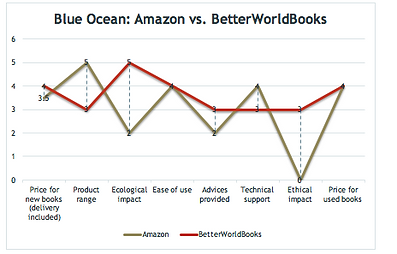

Blue Ocean
The Blue Ocean Strategy is a standard of a business strategy built by W. Chan Kim and Renée Mauborgne, researchers at Blue Ocean Strategy Institute at INSEAD. Its main goal is to answer the following question: How to create new strategic spaces?
Why Blue Ocean?
As explained in the section regarding the analysis of the book market, the latter has a high competitive environment. Therefore, in order to cope with this hostile environment (‘red ocean’), our team decided to bring about the Blue Ocean strategy. This approach will help us understand better our position within the market (and especially vis-à-vis Amazon) by providing us with the Strategy Canvas which is basically a descriptive graph (the vertical axis represents our scale (from 1 to 6) and the horizontal one shows the different criteria such as the price, delivery cost and so on. In other words, the canvas will be used to indicate the gap between certain activities in this market (for example there is a gap between the products range of Amazon and the ones of BWB). As might be expected, it is up to us, as consultants, to find gap-filling strategies that will strengthen BWB’s position in the market or even create a market where no competition is assessed (which is the state-of-art).
To sum-up, this concept is applied in our analysis to facilitate the establishment of BWB in Europe by enabling the implementation of efficient strategies that will help us shift from a fierce and competitive market to the so-called ‘Blue Ocean’.
In order to find out if there are such “blue oceans” in the book industry, we decided to use this framework on two different approaches.
The first approach will compare the offline and the online book selling market while the second one will compare Amazon and BetterWorldBooks. One can note that this analysis will be based on the European market and will not make use of the data available for the American market.
Blue Ocean : Amazon vs. BetterWorldBooks
The second analysis aims at comparing Amazon and BetterWorldBooks.

The criteria taken into account to compare Amazon and BetterWorldBooks are the following:
-
Price for new books (delivery included): thanks to economies of scale, Amazon is able to provide slightly cheaper prices for new books.
-
Product range: once again, amazon is able thanks to its size to provide a wider range of products.
-
Ecological impact: even though Amazon gives its customers the possibility to chose an ecological delivery, it has a much less environmentally conscious business approach than BetterWorldBooks.
-
Ease of use: since both are online retailers, ease of use is equivalent.
-
Advices provided: while Amazon provides some reviews, BetterWorldBooks has specific automated services designed to give its customers a list of books based on their preferences (see above).
-
Technical support: thanks to economies of scale, Amazon is able to provide a better service regarding technical support than BetterWorldBooks.
-
Ethical impact: while BetterWorldBooks insist on its willingness to have a positive ethical impact, Amazon does not have any program aiming at ethical objectives.
-
Price for used books: according to BetterWorldBooks, their prices for used books is similar to these of its competitors.
Any potential “Blue Oceans” will be further analysed in the section “strategy”. However, one can note the following gaps:
-
Ecological & ethical impact
-
Advices provided
-
Product range
-
Technical support
Blue Ocean Offline: vs. Online Book selling
Our first analysis will compare the offline and the online book selling market. Our conclusions are illustrated on the figure here below.

In order to provide a clearer view of potential blue oceans, it is necessary to detail the different characteristics taken into account:
-
Price : Due to the fixed price policy in most European countries (excepted in the U.K., see above), the difference in price between online and offline book selling is virtually zero. Indeed, while there may be some slight difference with a lower price for the online segment, delivery make the price gap almost inexistent.
-
Ease of use: it is clear that buying a book online is easier than going to a brick-and-mortar book shop.
-
Time for purchasing: while the process of buying a book in an offline shop takes time, only a few minutes are necessary to order a book online.
-
Advices provided: even though reviews on different books are available online, professional booksellers are much most suited for providing sound advices to their clients.
-
Product range: due to the nature of the online market, it is clear that the range of product available online is much higher than in bricks-and-mortar shops.
-
Time to delivery: since no delivery are required for offline bookstores, it is clear that it is much higher for the online book selling market.
From these observations, we can pinpoint two potential “Blue Oceans” that seem interesting to us:
-
Time for purchasing: A consumer buying from an offline bookstore will always need to get to the store at one point of the process (ordering or buying the book). Otherwise it would be an online bookstore.
-
Advices provided: from the online booksellers’ perspective, one solution to fill this gap would be the setting up of a specialised service to advice customers. This opportunity seems particularly interesting to us. It will be examined in the section dedicated to the strategy.
